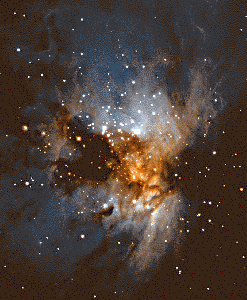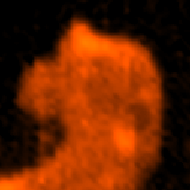
| The region around zeta Orionis, the left-most belt star in Orion. This image was taken on photographic film in visible light.
Notice the dark patches of molecular cloud material that make up the
dark dust lane in NGC 2024 (on the left-bottom) and the Horsehead
Nebula (right-middle).
|

| Here's a coarse image of the left-most nebula, NGC
2024, taken in infrared light (4 times "redder" than you can see
with your eye).
Compare this image with the one above -- notice that infrared
light can peer through the dark lane of obscuring gas and dust. This
infrared image reveals
hundreds of newly-forming stars, still cocooned in the reservoir
of material that formed them.
|

| To convince you that indeed there are molecules in these
clouds, here's an image taken in the microwave light of CO
(carbon monoxide)
molecules in the Horsehead Nebula (which is the famous dark patch of
obscuring dust you see in the visible-light image, above).
Notice that at these radio wavelengths, the molecular gas that
was dark and
obscuring in visible light is now what's luminous; and that
stars and nebulosity visible to the eye are now totally absent.
|





